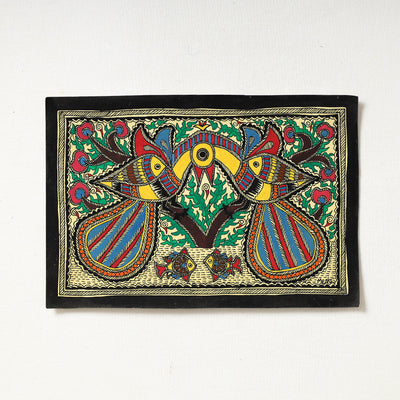iTokri believes our artisans are the foundation of our company. From handicrafts to paintings, Indian artisans can weave magic with their skills. We conducted an interview with one of our exceptional Patachitra artists to commemorate this unique partnership and learn more about his mesmerising art.

Patachitra painting is a 3000-year-old art form with its roots in Odisha. This cloth based scroll painting often depicts different mythological stories. Patua Painting from Bengal is also traditionally created on a pati (or patta), a piece of cloth. Kalighat Paintings, on the other hand emerged in the 19th century where one can notice depiction of mythological figures, women and their roles in the society.
iTokri celebrates Indian folk arts by bringing authentic art from different corners for the country.

Let us learn more this folk art from our Master Artist Laltu Chitrakar.
What is your name and where are you from?
My name is Laltu Chitrakar and I belong to the Paschim Medinipur District of West Bengal.
What kind of handicrafts do you specialise in?
I specialise in doing the famous Pattachitra painting of Bengal. The intricate details of the painting are inspired by folktales and mythological narratives.
How long have you been practising this craft?
Although I have been doing this art since childhood, however, for the last 15 years I got fully involved in Pattachitra painting.
Is your family also involved in the same craft?
My whole family is involved in this art including my brother, sister-in-law, and father. I am the 8th generation who is doing this Indian folk art.

Can you describe the process you go through when creating a piece of your handicraft?
What kind of materials do you prefer to work with?
We use natural colours on art paper, handmade paper, canvas, and fabric to draw Pattachitra paintings. We make natural colours from flowers, spices, grains, etc such as White colour from shells, brass hue from fried rice, purple from Aparajita flower, orange from the soil, green from leaves of beans, etc. Our folk art is ethnic and draws inspiration from Indian culture and history.
Do you use traditional techniques or have you developed your own?
As per the demand of the customer, we make alterations in the style of drawing Pattachitra's painting such as changes in motifs, lines, storyline, etc. However, more or less, we follow only traditional techniques by giving it a modern touch. Out folk paintings are authentic making it popular among people.
What challenges have you faced in creating these folk arts and how have you overcome them?
As we are not educated enough, we sometimes lack new ideas that help in building new stories. To make the new generation aware of the art, along with exhibitions, I started taking online sessions during lockdown and now I take live classes in Mumbai, Delhi, Bangalore, etc. Recently I took a class in Jabalpur, Madhya Pradesh.

Which is your favourite piece of Patachitra Painting that you have created and why is it your favourite?
I drew a Pattachitra painting for which I was awarded first prize in Mumbai in the Textile and Craft category. The painting was about the “Marriage of a Fish”. It got many accolades from the judges.
Are you the only one in your family doing this Indian folk art? Did any of your forefathers practice any of these arts?
This beautiful Indian folk art runs in our family for ages and I am the 8th generation who is keeping the art alive. At present, my father, aunt, and uncles all practice this art. I have learned this art from my father and uncles.
Will you teach your children the same traditional Indian art?
Yes, I will definitely teach my children about this beautiful art, as we have gained this skill from our forefathers and this art should not vanish over a period of time. Along with studies, I will motivate my kids to stay connected with the art and learn its intricacies.
How do you think this Pattachitra Painting can grow?
Compared to the past, painting has started to gain importance among people. Even NGOs are supporting us and I believe the future of Pattachitra Painting is bright.
Are you involved in any initiatives to preserve and promote traditional handicrafts?
Whenever I go to any college or institution, I narrate to students the story that if you shower your love on this art, the art will enhance your home decor, keep the art alive, and keep the artists motivated to keep going to preserve this beautiful art.
How has been your association with iTokri?
I am very happy with my association with iTokri. I was contacted by Nitin Sir from iTokri in the year 2012 and since then my bond with the platform has only got better every passing day. I get regular orders from iTokri. Via iTokri most of our paintings got sold in Madhya Pradesh. I extend my hearty wishes to the whole team of iTokri one of the best online store for Indian handicrafts.
 Verified Purchase
Verified Purchase
























Leave a comment (all fields required)